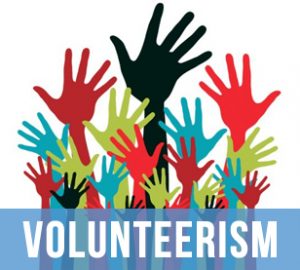July 1, 2016
RSVP: Lead With Experience
By Bill Sedlacek
Retired and Senior Volunteer Program of Eastern Iowa and Western Illinois
How the U.S. Compares in Volunteerism
 I’ve always believed that volunteering is woven in the fabric of our society to a greater degree than in others. One of the reasons for my belief is that the industrialized countries of Western Europe and Canada have more governmental involvement in the welfare of their citizens. I thought this would result in less need for volunteers and consequently less volunteering to help those who may stumble on the sometimes rutted footpath of life.
I’ve always believed that volunteering is woven in the fabric of our society to a greater degree than in others. One of the reasons for my belief is that the industrialized countries of Western Europe and Canada have more governmental involvement in the welfare of their citizens. I thought this would result in less need for volunteers and consequently less volunteering to help those who may stumble on the sometimes rutted footpath of life.
For comparison, I looked at official government’s reports from the United States, Canada and the European Union that are in a similar format and cover approximately the same time periods. I used our Bureau of Labor Statistics ‘Volunteering in the United States,” a similar Canadian publication, Statistics Canada, and the European Union report “Volunteering in the European Union.”
Well, get ready for a surprise. Here 25 percent of our citizens volunteer. Of all age groups, our 55 to 64 year old folks volunteer the most. In our youngest age group, 16-24, 22 percent volunteer. In comparison, 44 percent of all Canadians volunteer. In their 15-24 age group, 58 percent volunteer. What’s wrong with those young Canadians? Haven’t they heard of Play Station, X-Box, Face book, or U-Tube? Looking at the European Union, any comparison is difficult because of the number of separate countries and cultures there. Just comparing those countries that I would view as most like us, the rate of volunteering is also higher. Overall it is over 40 percent in Austria, The Netherlands, Sweden, and the UK (where the Salvation Army got its start in 1865) and 30 -39 percent in Denmark, Finland, Germany and Luxembourg. One interesting fact is that of the over 75 year old folks, one in four in Austria and one in five in the Netherlands volunteer.
The lowest rates are generally in the former Soviet Block countries where volunteer activities were brought under state control during their time in the Soviet Union and the private volunteering infrastructure has not fully recovered
The studies also look at the cost benefits of volunteer activity. Volunteer work is priced at the cost of having it done by a paid individual and that value is added to the country’s GDP. In Canada, volunteer cost benefits represent 3 percent of their GDP. The European Union figures are mixed and range between 3 and 5 percent in Austria, the Netherlands and Sweden and around 2 percent in the UK, Finland and Denmark. The former Soviet Union countries are the lowest, some with volunteer work providing less than .01 percent of additional GDP. Check my math on this, but with a GDP of 17 trillion and a volunteer effort of $173 billion, the United States volunteer benefit of about .1 percent of GDP.
Why does the rest of the Western Industrialized world volunteer at a rate higher than us? Is it because we put in a longer work week (41.3 hours) than Canada (35.6 hours) and the European Union countries like France (35 hours)? Does a shorter work week leave them more free time to volunteer? Or do they have a greater sense of community than us, care about their fellow citizens more and volunteer as an expression of that care? I would rather not think that is true. On average the countries that have higher volunteer rates also have a higher average life expectancy than us. That must be more than a coincidence. Think about the one in four or five 75 year old folks who volunteer in Austria and the Netherlands. I wonder if the physical and mental stimulation associated with volunteering buys them a few extra couple of years to watch their great grandchildren grow up. Could it do the same for you?
To learn more about the many opportunities to volunteer in our area, call RSVP (309) 793-4425 or email rsvp@wiaaa.org.
Filed Under: Community
Trackback URL: https://www.50pluslife.com/2016/07/01/rsvp-lead-with-experience-29/trackback/


